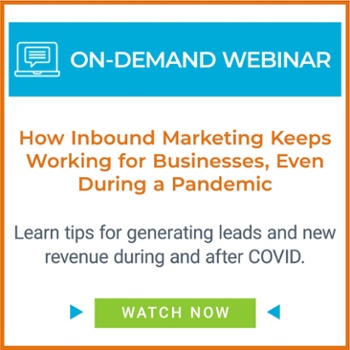5 Tips to Activate Your Blog Content and Boost Your Conversions
You have a blog. Great. Are you analyzing it? Are you tracking its performance? Do you know if your efforts are paying off? Time is money, and if...


Did you know that 74% of organizations rely on inbound marketing, and that over half of marketers believe that inbound marketing leads to higher ROI? In today’s Internet-driven world, inbound marketing is powerful, and makes an impact on every aspect of your business.
One of the biggest benefits of inbound marketing is that it’s more likely to get you a sales qualified lead than traditional marketing. When you use inbound marketing and increase leads, that eventually gets you more sales and loyal customers.
But you may not be sure where to start. Inbound marketing is vastly different from traditional marketing, and takes a lot of strategizing, research, and constant work. It’s worth putting in the work — but it can be overwhelming to think about how to do it.
That’s why we’ve put together this guide.
If you’re looking to increase your sales qualified leads by using inbound marketing, we can show you the ways to do that. By clarifying the process for you, you can focus on what matters most: running your business. Read on to learn more.
 Before we cover the different inbound marketing strategies you can use to find leads, we’ll cover what inbound marketing is, especially how it’s different from traditional marketing. Once you understand how it works, it’ll be easier to apply the strategies we give you.
Before we cover the different inbound marketing strategies you can use to find leads, we’ll cover what inbound marketing is, especially how it’s different from traditional marketing. Once you understand how it works, it’ll be easier to apply the strategies we give you.
Traditional marketing — also called outbound marketing — is exactly what it sounds like. This is where you put your marketing out into the world, attempting to get the attention of potential customers by using billboards, brochures, Internet ads, cold calls, commercials, and print advertisements.
You’re simply putting this content in front of potential customers and hoping that they’ll get in touch. But this is an outdated strategy that many customers, especially millennials and Gen Zers, are turned off by.
Inbound marketing, on the other hand, engages potential customers. It helps them with their pain points, providing solutions to problems, informing them, and entertaining them too.
RELATED POST >>> It's Not Inbound Vs. Outbound: 4 Ways Inbound & Outbound Marketing Tactics Improve Each Other's Effectiveness
Examples of inbound marketing include blog posts, email newsletters they’ve subscribed for, videos, social media posts, and using search engine optimization (SEO) to get your page to show up higher up in search results when a customer is looking for content related to your products or services.
Why do you need it? Because it’s incredibly effective. According to Fundera, 81% of shoppers research online before purchasing, and customers who engage with businesses on social media spend up to 40% more long-term with them.
If you’re looking to increase your leads, use the following inbound marketing strategies to make it happen.
For inbound marketing to be effective, you need to understand who your leads are. This will help you create content, especially for them, and know where and when to post it on social media.
Start by creating a target persona. This is a fictionalized version of who you imagine being your ideal customer. When creating the target persona, get as detailed as you can.
RELATED POST >>> Stop Trying to Boil The Ocean >>> Segment Your Target Market
Write down details related to demographics (such as their age, gender, and where they live), information about their work situation (such as their position and industry), and their personality (how would you talk to them, and what will they react positively to?).
Additionally, you’ll want to think about their shopping habits and needs. What are their goals, and how can you help them achieve that with the product or service you offer? When they buy something, why do they do it?
All of this will help you create content that solves your leads’ problems, interests them, and entertains them. You’ll also be able to develop a tone throughout your blog posts, web copy, and social media posts that they’ll be most receptive to.
As you build your target persona, you’ll probably find that you’re marketing your business to more than one specific person. Some customers might be millennials, while others might be baby boomers, for example.
When this happens, you need to segment your leads. Otherwise, you’re creating one type of content for different people, which will inevitably drive away some of your customers.
Once you’ve created your target persona and segmented leads as needed, it’s time to start creating some content and using strategies. To help lead what you decide, you’ll want to be aware of the different types of strategies you can use to get lead attention and convert these leads into paying clients or customers.
Content that attracts leads is used to get the interest of these leads. By creating content that’s valuable to them, you start a conversation, getting them to engage with you.
They’ll see you as an authority in your industry who has information that they want to understand better.
Content and strategies that engage give your potential customers solutions to the problems they’re experiencing, easing their pain points. For example, if you sell products for working moms, your content might provide them with tips on how to stay productive while still making time for their kids.
When you’re using the delight strategy, you’re helping your customer after they’ve purchased your product or service. This guarantees that they’ll come back to you and become loyal customers.
Some examples of delight strategy include assisting your customers with a chatbot or using surveys to ensure they’re satisfied with what they’ve bought.
Social media is a big part of inbound marketing. Without it, you might feel like you’re creating content but that it isn’t being noticed by anyone. But with social media, you’ll get it out to potential leads, engaging with them and converting them.
Going back to your target persona, if you’ve segmented your leads—research where and when they spend the most time online. This will let you know whether you should be posting that sure-to-be-viral video on Facebook, Instagram, or Twitter.
You’ll also know whether it’s best to post it in the middle of the day and what hashtags to use to get attention. Use a tool like Later to help you plan and schedule your posts.
Speaking of hashtags — the text on your social media posts matters, too. This should be in the right tone that matches the communication style and personality of the buyer persona you’ve created.
Additionally, don’t forget about the importance of engagement. If you post about your Facebook product and potential customers start asking questions about it in the comments, like their comments and reply to them. This makes them feel that you value them, which means they’ll value what you have to offer.
RELATED POST >>> 4 Ways to Start Your Social Media Marketing Strategy
Search engine optimization (SEO) is an incredibly important part of inbound marketing. With it, customers are more likely to end up on your website instead of a competitor’s when they’re searching for a product or for an answer to a question related to your industry.
How do you master SEO? There are many different ways, but the main way is by creating SEO-optimized content. Blog regularly, and when you do, write about topics that your leads would type (or speak) into Google.
RELATED POST >>> 3 Widespread Myths About On-Page SEO
These word-for-word search terms are called keywords, and you’ll want to sprinkle them throughout your blog posts and other content in a way that feels natural.
Other ways to optimize your website for SEO are by ensuring that it loads quickly (which you can test with Google’s PageSpeed Insights), optimizing it for mobile use, and getting quality backlinks.
One of the drawbacks of inbound marketing is that many businesses are using this strategy now. That means that, at this point, your potential customers are getting inundated with inbound marketing content.
That’s why it’s so important to use the right hacks. With them, you’ll get through to your customers despite all the other content out there. These strategies include:
Creating high-quality, researched content that is helpful and informative
Nurture your leads with top of funnel content
Create an online community for your potential customers, where they can engage with each other and feel included in your company culture
Use click-to-messenger ads
Be kind to your clients, and they’ll be kind to you by spreading the word about your product or service once they’ve bought it
Create educational premium content, which can provide more value than a simple blog post
By using these strategies, you’ll get noticed more than your competitors do, which means your audience is more likely to engage with you. This means more leads in the long-term.
Do you need more help with using inbound marketing to get you that sales qualified lead? Maybe you have questions about what content creation is best for you, or you want to improve your SEO with additional strategies.
Whatever your needs, we can help you at LeadG2. Visit our contact us page to learn more.

You have a blog. Great. Are you analyzing it? Are you tracking its performance? Do you know if your efforts are paying off? Time is money, and if...

In today's competitive business landscape, effective marketing and sales strategies are crucial for business success. An inbound marketing content...

Whether you're a small startup or a well-established enterprise, consistently attracting new prospects is essential for growth. One common strategy...